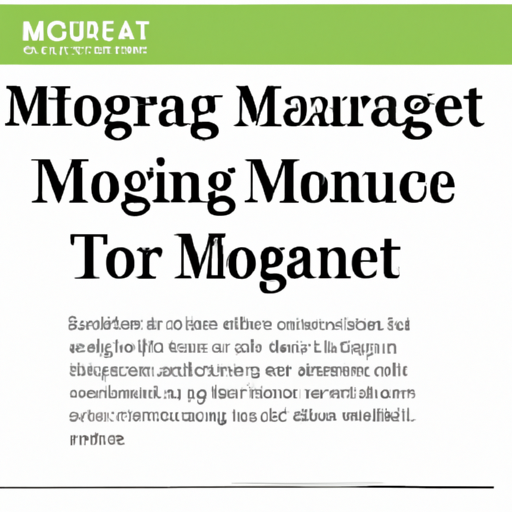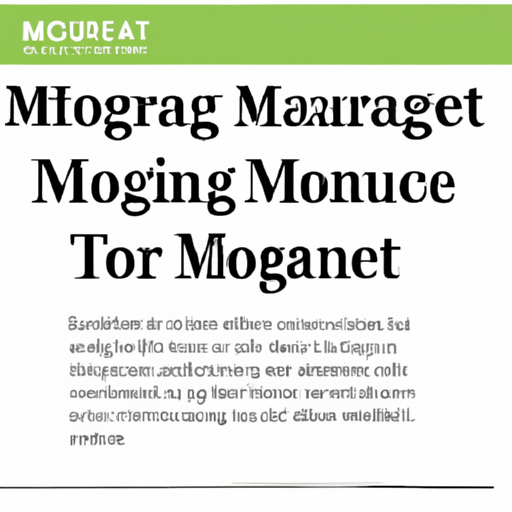Mortgage Industry Trends
In this article, you’ll discover the latest mortgage industry trends that are shaping the future of the housing market. From changing interest rates to evolving buyer preferences, these trends provide invaluable insights for both homebuyers and industry professionals alike. Whether you’re considering purchasing a new home or simply curious about the state of the market, this article will give you a comprehensive overview of the key factors driving the mortgage industry today. Stay informed and make informed decisions with our in-depth analysis of mortgage industry trends.

Table of Contents
H2: Introduction
In recent years, the mortgage industry has undergone significant changes and experienced various trends that have shaped the landscape for borrowers and lenders alike. These trends have been influenced by a range of factors, including economic conditions, technological advancements, and regulatory changes. In this article, we will examine some of the key trends in the mortgage industry and their implications for different stakeholders.
H2: Rise in Mortgage Rates
H3: Impact of Federal Reserve Decisions
One notable trend in the mortgage industry has been the rise in mortgage rates. The Federal Reserve plays a significant role in shaping these rates through its monetary policy decisions, particularly with regards to the federal funds rate. When the Federal Reserve raises interest rates, it becomes more expensive for lenders to borrow money, which in turn leads to higher mortgage rates for borrowers.
H3: Effect on Homebuyers and Refinancing
The increase in mortgage rates has had a significant impact on homebuyers and those looking to refinance their existing mortgages. Higher mortgage rates mean that borrowing money becomes more expensive, potentially making homeownership less affordable for some individuals. Additionally, those looking to refinance their loans may find that the higher rates make it less attractive to do so, as the potential savings from refinancing may be diminished.
H3: Implications for the Housing Market
The rise in mortgage rates also has implications for the overall housing market. Higher rates can dampen demand for homes, as potential buyers may be discouraged by the higher cost of borrowing. Additionally, higher rates may lead to a slowdown in home price appreciation, as buyers may be less willing or able to afford higher-priced homes. This can have a ripple effect on the economy, as the housing market is closely tied to other sectors such as construction and home improvement.
H2: Increase in Digital Mortgage Lending
H3: Advancements in Technology
Another significant trend in the mortgage industry is the increase in digital mortgage lending. Advancements in technology have made it possible for borrowers to apply for mortgages online, streamlining the application process and making it more convenient for borrowers. Digital mortgage lending platforms often utilize automation and data integration to expedite the underwriting process, allowing for faster loan approvals.
H3: Benefits for Borrowers and Lenders
Digital mortgage lending offers several benefits for both borrowers and lenders. For borrowers, the convenience and accessibility of online applications make it easier to navigate the mortgage process. These platforms often provide tools and calculators to help borrowers understand and compare their options. For lenders, digital mortgage lending can help streamline their operations, reduce costs, and improve efficiency. The use of automation and data integration can minimize manual errors and streamline paperwork, resulting in faster loan processing.
H3: Impact on Traditional Mortgage Process
The rise of digital mortgage lending has also had an impact on the traditional mortgage process. Traditional banks and credit unions are facing increased competition from non-bank mortgage originators, who often leverage technology to offer more streamlined and efficient services. This has forced traditional lenders to adapt their processes and invest in technology to remain competitive in the market.
H2: Housing Affordability Challenges
H3: Rising Home Prices
One of the significant challenges in the mortgage industry is the rising home prices. As demand for housing continues to outpace supply, home prices have been steadily increasing in many markets. This trend has made it more difficult for potential homebuyers, particularly first-time buyers, to enter the market. Rising home prices can also make it challenging for homeowners to afford larger or upgraded homes, potentially limiting their housing options.
H3: Limited Inventory
Another factor contributing to housing affordability challenges is limited inventory. The supply of homes for sale has not kept pace with demand, leading to a shortage of available properties, particularly in desirable markets. Limited inventory can lead to increased competition among buyers, driving up prices and making it difficult for some individuals to find suitable housing options.
H3: Impact on First-Time Homebuyers
The combination of rising home prices and limited inventory has had a significant impact on first-time homebuyers. These individuals often face more significant challenges in saving for a down payment and qualifying for a mortgage. As home prices continue to rise, the affordability gap for first-time buyers widens, making it increasingly difficult for them to enter the housing market.
H3: Solutions and Initiatives
To address housing affordability challenges, various solutions and initiatives have been proposed and implemented. These include measures such as down payment assistance programs, tax incentives for first-time buyers, and the development of affordable housing units. Additionally, there has been a push for increased construction of new homes to help alleviate the supply shortage. These measures aim to make homeownership more accessible and affordable for a broader range of individuals.
H2: Expansion of Alternative Lenders
H3: Growth of Non-Bank Mortgage Originators
The mortgage industry has also witnessed the expansion of alternative lenders, particularly non-bank mortgage originators. These entities, such as online lenders and fintech companies, have gained market share by offering innovative and streamlined lending solutions. Non-bank mortgage originators often leverage technology and data analytics to provide faster loan processing and more personalized services.
H3: Peer-to-Peer Lending Platforms
Another area of growth in alternative lending is peer-to-peer lending platforms. These platforms connect individual lenders with borrowers, often eliminating the need for traditional financial institutions as intermediaries. Peer-to-peer lending can provide borrowers with access to funding that may not be available through traditional lenders and offers lenders the potential for higher returns on their investments.
H3: Impact on Traditional Banks and Credit Unions
The expansion of alternative lenders has had implications for traditional banks and credit unions. These institutions are facing increased competition from non-bank mortgage originators and peer-to-peer lending platforms. To remain competitive, traditional lenders are exploring partnerships with fintech companies and investing in technology to enhance their offerings and improve the customer experience. This shift in the lending landscape has led to increased diversity and options for borrowers, but also presents challenges for traditional lenders in maintaining market share.
H2: Surge in Online Mortgage Applications
H3: Convenience and Accessibility
With advancements in technology, there has been a surge in online mortgage applications. Borrowers can now conveniently apply for mortgages from the comfort of their own homes, without the need for in-person visits to a lender. This convenience and accessibility have made the mortgage application process more efficient and user-friendly for borrowers.
H3: Streamlined Application Process
Online mortgage applications typically offer a streamlined process compared to traditional paper-based applications. Borrowers can input their information online, which is then automatically processed and verified by the system. This reduces paperwork and manual errors, allowing for faster loan processing and approval times.
H3: Security and Privacy Concerns
While the rise of online mortgage applications has brought many benefits, it has also raised concerns regarding security and privacy. Borrowers must provide sensitive financial and personal information when applying for a mortgage online, which can make them vulnerable to cyber threats. Lenders and fintech companies must invest in robust security measures to protect customer data and ensure privacy.
H2: Rise of Mortgage Technology Startups
H3: Innovation in Mortgage Services
The mortgage industry has seen a rise in mortgage technology startups, bringing innovation to various aspects of the mortgage process. These startups are leveraging technology to develop new solutions and improve efficiency in areas such as loan origination, underwriting, and servicing. By leveraging automation, data analytics, and AI, these startups aim to revolutionize the traditional mortgage industry.
H3: Disruption of Traditional Mortgage Industry
The emergence of mortgage technology startups has the potential to disrupt the traditional mortgage industry. These startups often offer more streamlined and efficient services, challenging traditional lenders to adapt and improve their offerings. The increased competition and innovation in the industry can ultimately benefit borrowers by providing them with more options and improved customer experiences.
H3: Opportunities and Challenges
While the rise of mortgage technology startups presents opportunities for borrowers and lenders, it also brings challenges. Traditional lenders may need to invest in technology and reshape their processes to remain competitive. Additionally, the adoption of new technologies may require additional training and resources for mortgage professionals. However, the potential benefits in terms of improved efficiency, cost savings, and enhanced customer experiences make it worthwhile for the industry to embrace these innovations.
H2: Evolution of Mortgage Underwriting
H3: Use of Big Data and Artificial Intelligence
The evolution of mortgage underwriting has been driven by advancements in big data and artificial intelligence (AI). These technologies enable lenders to gather and analyze vast amounts of data to make more accurate assessments of a borrower’s creditworthiness. By leveraging AI algorithms, lenders can automate the underwriting process and swiftly evaluate loan applications.
H3: Faster and More Accurate Decision-Making
The use of big data and AI in mortgage underwriting has led to faster and more accurate decision-making. Lenders can now assess a borrower’s creditworthiness based on a broader set of data points and analyze trends and patterns to identify potential risks. This enables lenders to make more informed lending decisions, reducing the chances of defaults and improving the overall quality of their loan portfolios.
H3: Risks and Ethical Considerations
While the use of big data and AI in mortgage underwriting offers benefits, it also presents risks and ethical considerations. The reliance on algorithms and automated decision-making can potentially perpetuate bias and discrimination in lending practices. It is crucial for lenders to ensure transparency and fairness when implementing these technologies to mitigate these risks and ensure equal opportunities for all borrowers.
H2: Emphasis on Customer Experience
H3: Personalized Mortgage Services
With increased competition and advancements in technology, there has been a growing emphasis on providing a personalized customer experience in the mortgage industry. Lenders are focusing on understanding and meeting borrowers’ specific needs and preferences. This includes tailoring loan products, providing personalized support and guidance throughout the mortgage process, and offering flexible options to accommodate individual circumstances.
H3: Integration of Online and In-Person Interactions
To enhance the customer experience, lenders are striving to integrate online and in-person interactions seamlessly. Borrowers can initiate the mortgage application process online and then have the option to connect with a loan officer or customer service representative for further assistance. This combination of online convenience and human support aims to provide borrowers with the best of both worlds.
H3: Importance of Transparency and Communication
In the quest to improve the customer experience, transparency and effective communication have become crucial elements. Lenders are placing a greater emphasis on providing clear and comprehensive information to borrowers, ensuring they understand the terms and conditions of their loans. Regular communication and updates throughout the mortgage process help borrowers feel informed and supported, fostering trust and loyalty.
H2: Regulatory Changes and Mortgage Compliance
H3: Impact of Dodd-Frank Act
Regulatory changes have had a significant impact on the mortgage industry, particularly since the passage of the Dodd-Frank Act in response to the 2008 financial crisis. The act introduced new requirements for mortgage originators and lenders to enhance consumer protection and ensure responsible lending practices. These regulations have increased compliance burdens for lenders, necessitating changes in processes and documentation to meet regulatory standards.
H3: Updates in Mortgage Consumer Protection
In recent years, there have been further updates in mortgage consumer protection regulations. These updates aim to enhance transparency and improve disclosure practices to protect borrowers from predatory lending practices. Lenders must ensure compliance with these regulations and provide borrowers with accurate and understandable information regarding their mortgage terms, fees, and risks.
H3: Future of Mortgage Regulations
The mortgage industry continues to evolve, and so do the regulations governing it. As technological advancements and market dynamics change, regulators are likely to adapt regulations to address emerging challenges and risks. Future regulations may focus on areas such as data privacy, cybersecurity, and the use of advanced technologies in the mortgage process. Lenders and industry stakeholders must stay informed and prepared to navigate the evolving regulatory landscape.
In conclusion, the mortgage industry is undergoing significant changes driven by various trends. Factors such as rising mortgage rates, advancements in technology, housing affordability challenges, the expansion of alternative lenders, and the evolution of mortgage underwriting are shaping the industry landscape. It is crucial for borrowers, lenders, and regulators to navigate these trends and developments effectively to ensure sustainable and responsible lending practices and provide borrowers with accessible and affordable mortgage options.






